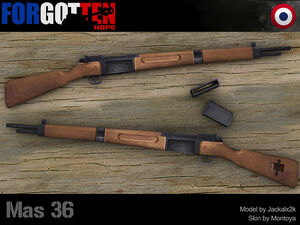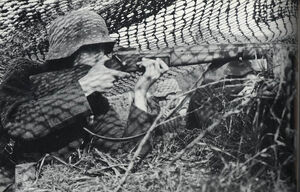| MAS-36 Gewehr 242(f) | |
|---|---|

| |
| General Historical Information | |
| Place of origin | France |
| Manufacturer | Manufacture d'Armes de Saint-Etienne |
| Type | Bolt action rifle |
| Effective range | 600m |
| Magazine | 5 rounds |
| Ammunition | 7.5×54mm French |
| General Ingame Information | |
| Used by | France Germany |
| Bayonets | Mle 1936 MAS (Bayonet) |
| Rifle grenades | Schiessbecher (see pic) |
| Scope | Unknown type from FH (see pic) |

| |
The MAS-36 is a French bolt action rifle. Adopted in 1936, the MAS Modele 36 was intended to replace the aged Berthier and Lebel rifles and was known to be the last bolt action service rifle to be adopted for military use anywhere. However, budget constraints limited its production, and during the Second World War it had to be used alongside earlier rifles in many French army and colonial units. After the Battle of France, the Germans took over a large number of MAS-36s, which were given the designation Gewehr 242(f) and put into service with their own garrison units based in occupied France and later the Volkssturm. The MAS-36 was used extensively after WWII by the French Army, as well as colonial forces in the First Indochina War, Algerian War, as well as in the Suez Crisis. It was used to launch grenades. The Schiessbecher ingame is most likely meant to substitute for the Viven-Bessières rifle grenade, which was used in both world wars and beyond.
There is a scoped rifle variant of the MAS-36, like some other scope rifles the cross hair has been removed since the scope blocks the iron sights. While prototypes had been made a MAS-36 with a scope was never issued by the French army in WWII. Berthier and Lebel were used as sniper rifles.
| ||||||||||||||||||||||||||||||||||||||
| |||||||||||||||||||||||






